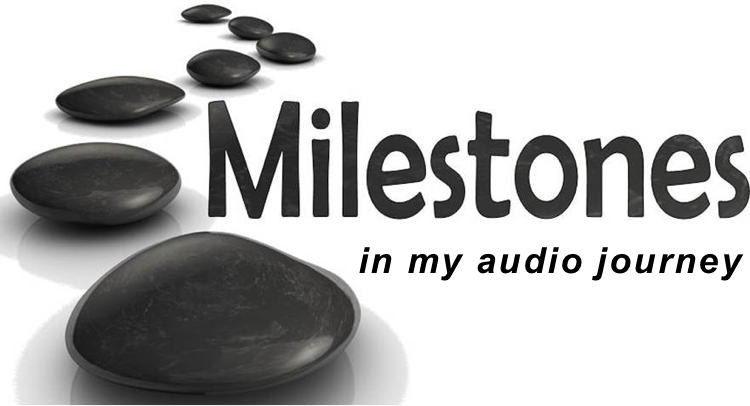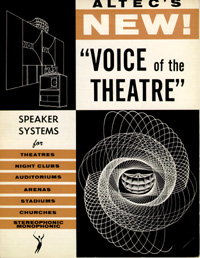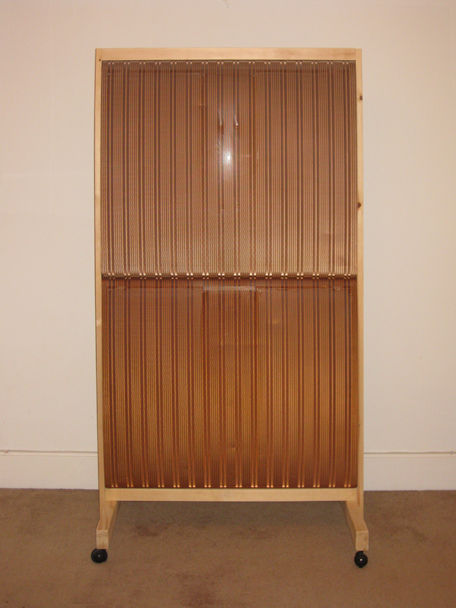
Recently I had my 64th birthday, and I’ve been thinking about milestones in my life. It crossed my mind that I have just passed the biggest one in my audio life. I have now owned my Teresonic Ingenium XR speakers with Lowther DX4 drivers and silver-wound voice coils for ten years. This is the longest that I have ever owned a pair of speakers.
Sure there have been some temptations. Two of these temptations were from nostalgia. First, I wanted to see if Quad ESLs were as good as I remembered, and the answer was yes and no (you can read more here). The second was that I wanted to hear some version of the Altec VOTs, but again the answer was that I preferred my Teresonics.
The only real temptation came from the Devore Fidelity Orangutan O/96 speakers. So far, they are the only speakers I have heard for under $30,000 that really tempted me, and they tempted me so much that I even talked to a couple of people about buying my Teresonics. In the end, I put the Teresonics back in my system, and I decided to stay with them, but man I loved those Orangutans.
This reminiscing led me down memory lane, and I started to daydream about a few major surprises and some major let downs from my audio past. Then, a question popped into my mind, “What milestones, if any, would help readers know me better and help them evaluate their own audio history?” So I hope you will enjoy a few ramblings and maybe learn something along the way as well.
Milestone 1 – Recorded music can sound better than I knew

Here, I think I’ll start with my freshman year at Baylor University. I was 17 and loved music just as much as I do now, but it was mostly Led Zeppelin, the Doors, the Stones, Janis, Cat Stevens, Linda Ronstadt and others like that. It was about this time that I discovered there was something that sounded better than the little system I had purchased from Allied Radio.
You’ll laugh, but I heard the first system that played close to real music, and it sounded fine to me. It was owned by one of the rather geeky professors and consisted of a pair of Altec Voice of the Theater speakers, McIntosh tube equipment and a Garrard 301 table with an Ortofon moving coil cartridge.
Well, I was hooked but broke, so I got a job at an audio store. I saved my funds, and I visited every audio store from Austin to Dallas. Somehow by the start of my sophomore year, I had scraped up enough for a small system that consisted of a Kenwood receiver, KLH 17s, an AR turntable and a Pickering cartridge. I had this set up in my dorm room with a speaker in each window and a bean bag for a listening chair.
Milestone 2 – It’s how real the midrange sounds that matters
I was happily buying records and listening to music with no idea what an audiophile was when, cruelly, Ken Askew showed up at Baylor with Quad 57s. I had a used Mac tube receiver out for evaluation. We hooked it up and played his Quads sitting right next to each other in my dorm room. I was shocked, I mean truly shocked! This was to shape my way of thinking about recorded music until this very day. In my mind, I will always remember the transparency, nimbleness and air that the Quads had in the midrange. I know I remember them a little too fondly, but is a speaker, along with a few other that has held up to the test of time.
There was a lesson to be learned from the original Quad ESLs, an important lesson. I learned that the heart and soul of music is in the midrange and that the midrange can be transparent, full and tactile all at the same time. This seems so obvious now, but back then everyone was wanting to know how deep does the bass go, is the treble flat out to 20k and how low is the total harmonic distortion. I became more concerned from that moment on to be more concerned about how open was the midrange window on the performance.
Milestone 3 – Memaw was even right about audio
 The next milestone for me was when quadraphonic recordings and decoder came out. It was a total flop and I think it should have been, but there sure was a lot of excitement over it at the time. I think part of what caused this excitement was that with the new cassette players with shock control, we had for the first time something better than an AM/FM radio in our cars. A lot of guys I knew loved having the sound all around them in the car and wanted this in their home systems.
The next milestone for me was when quadraphonic recordings and decoder came out. It was a total flop and I think it should have been, but there sure was a lot of excitement over it at the time. I think part of what caused this excitement was that with the new cassette players with shock control, we had for the first time something better than an AM/FM radio in our cars. A lot of guys I knew loved having the sound all around them in the car and wanted this in their home systems.
The only quadraphonic or surround sound system I have ever heard that I truly thought was musically realistic was from this time period. Gene of Hillcrest High Fidelity in Dallas had stacked Quad 57s in the front and a pair of EPI 50s hanging in the top back corners of a very large room. He used a little Dynaco passive kit to drive the EPI 50s. You didn’t even know they were playing unless he cut them off. When he turned them off, you noticed a loss of ambiance and air. With Gene’s setup, you never heard instruments or people from the rear. While I liked this, in the end, I still thought it reduced the overall transparency of the stacked Quads.
My Memaw had been right when she said that just because something is new and improved doesn’t mean it’s better. Inherent in this was that great two-channel sound is more satisfying to me than multichannel sound systems. Now that I have spent some time with mono cartridges, I sometimes wonder if one channel wasn’t enough.
Memaw’s new and improved advice wasn’t only true about the system, but about the components as well. It has often been true of new speaker technologies, new cartridges and even new mediums. Just remember, “Just because it’s new and improved, doesn’t mean it’s better.”
Milestone 4 – Cables make a difference
One day I was visiting Mike Shotts at Soundtracks in Auburn, Alabama, and he said he had something I had to hear. I looked around the showroom for something new and didn’t see anything. Then Mike showed me some speaker wire. They were the Fulton speaker cables. These cables came in two models, brown and gold, and they were very popular in the early 1980’s. As far as I know, they were the first audiophile speaker cables, so they actually created this new component category. They were never that good, but they sounded better than lamp cord, which I found hard to believe. I mean how could wire make a difference.
The first cables that I ever heard make a huge difference were the Polk Cobra cables in “shotgun” runs. Over the years, I have heard many cables at many different price points. I have reviewed a lot of cables and my three favorite cables vary in price from $250, to $3,575, to $15,500 for three meters of speaker cable. This in itself seems ridiculous, but you want to hear something more ridiculous, which one of the three sounds best depends on the equipment you use them in. This may seem unimportant depending on if $250 or $3,575 or $15,500 is a lot of money to you, but what would you do if you could afford and had purchased the $15,500 and discovered that in your system the $250 cables sounded better? Cables can be a real pain, but they do make a difference. Nowadays, you will find the cables listed as part of the components in a room at an audio show, and depending on the cables, they can really drive up the cost of a system.
Milestone 5 – Your room is a component
 This one is easy to state and difficult to implement, though not as difficult as some make it out to be. Simply stated it was when I discovered that the room is a component of the audio system. I had already learned about speaker placement from being a Quad 57 owner, but there was so much more.
This one is easy to state and difficult to implement, though not as difficult as some make it out to be. Simply stated it was when I discovered that the room is a component of the audio system. I had already learned about speaker placement from being a Quad 57 owner, but there was so much more.
In the mid-80s, I met two men, one named Jim and one named Bill, and they couldn’t have been more different. Jim Smith, who at that time owned Auditions in Birmingham, Alabama, was one of the most honest and helpful people I have ever met in audio and that is true to this day. If you don’t own his book and have the DVDs called Get Better Sound, you need to stop what you’re doing now and order them. Here’s the link to order either or both of these items.
On the other hand, Bill whose last name I will not share, was to put it mildly, not to be trusted, and because I trust everyone, I learned this the hard way. Still, Jim and Bill had one thing in common, they could both set up a room of equipment so that it sounded incredible. This was news to me at the time. I knew the room made a difference, but I had no idea how much. Over the next few years thanks to Jim Smith and Mike Shotts of The Soundtracks in Auburn, Alabama I learned much about setting up a system in a room. By the way, I also owe these two men, who I count as friends to this day, for teaching me how to set up a turntable ant tonearm.
Milestone 6 – Corrupted power can be helped
I wanted to say power corrupts, pun intended, but that wasn’t the milestone. I had known for years that AC power had a big effect on the sound of my systems. Becky would kid me about wanting to listen late a hight when there was good power. I tried all kinds of things including a dedicated line. I tried different kinds of isolation devices and devices that kept power at a steady voyage and even a Furman Power Station, none of these helped, and most made the sound worse. Where I lived did make a difference and so did the dedicated line, still the sound was grungy and the background not nearly as quiet in the times of high power usage as it was late at night.
The milestone came in 1998 when my long-time audio bud, Steve Woolsey, called me about these power cables he had bought from a company called Shunyata Research, and the cable was named after some kind of snake. He had ordered one that cost $400, and it so impressed him that he had ordered another that cost $1,000. I thought he had lost his mind; I mean who ever heard of paying for a power cord, and how could the last five or six feet of wire that ran from a power plant somewhere to my house and then through the wire in my house make any difference. I highly suggest if you have wondered the same thing that you read an article by Galen Carol entitled Why Power Cables Make a Difference.
I am an audiophile though, so I made the two hour trip to Steve’s house to hear these power cords. I was shocked! I could easily hear a difference, and unlike most power cleaning devices I had tried, the difference was for the better without a doubt. So guess what, I sold my Furman Power Plant to get some money and purchased two of the entry-level power cords from Shunyata Research. I was very pleased. The power cables made a much more positive difference in the sound than anything else I had tried to clean up the power.
The audio industry has learned a lot over the years about dealing with the dirty power that comes out of our wall sockets. I have reviewed some really outstanding power conditioners from Audience, Synergistic Research, and Torus. Over the last five years, I have come to feel that the very best power distribution products use good power cords. The very best of the power distributors are from HB Cable Design of Germany, but I was very impressed when I reviewed the WyWires Power Broker, which is much more reasonably priced. As far as the current state of power cables goes, it seems the sky’s the limit on price, but you can’t go wrong with the power cords from Audience, High Fidelity Cables, or WyWires, and they don’t have to cost in the 5 figures. Saying this, there are other power products out there that may be just as good, and I welcome hearing about them and reviewing them.
Milestone 7 – Emotional involvement is most important to me
In the last 45 years, I’ve seen our hobby go through a lot of trends. When I first got into audio everyone was going to transistors because they measured so good. Next, William Johnson started Audio Research and Harry Pearson published The Absolute Sound, and there was a big trend back to tubes that has continued to this day. Now there are tube amps that sound like transistor amps and vice-versa. Harry Pearson was also responsible for the overwhelming fascination with sound staging, which was both good and bad. Sound staging is wonderful when it is natural and not distracting from the music, but a great soundstage in itself does not make a musically interesting system. Then, there was a small trend toward SET tube amps and high power speakers. This was the trend that brought me back to remembering how emotionally involving recorded music could be.
I’m at the point in my life now that I get to hear lots of live music, and if an audio system can[‘t bring me a good slice of that feeling of being moved by the music, I’m not interested in listening to it for very long. If it can do that, then I look for ways to improve the sonics we enjoy from our system like transparency, detail, sound staging, imaging and so forth. I have experienced this magic from tubes and transistors and from high-efficiency and normal efficiency speakers. For the money I can afford at this time, my reference system does this for me at home, but it’s not the only system that has given me this experience in my home or somewhere else.
I hope these milestones of mine will help you evaluate what you’re truly are looking for from your audio system.
